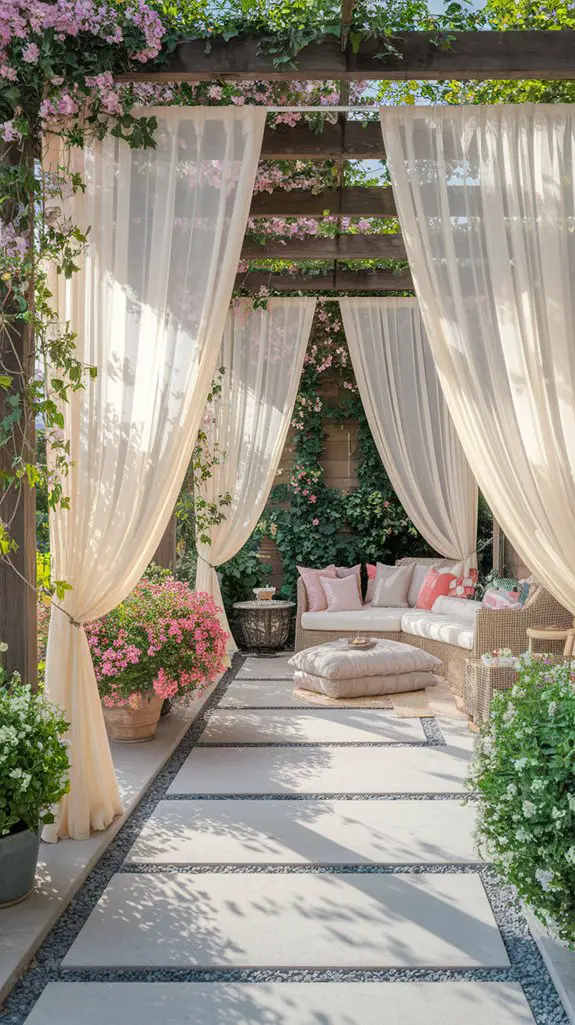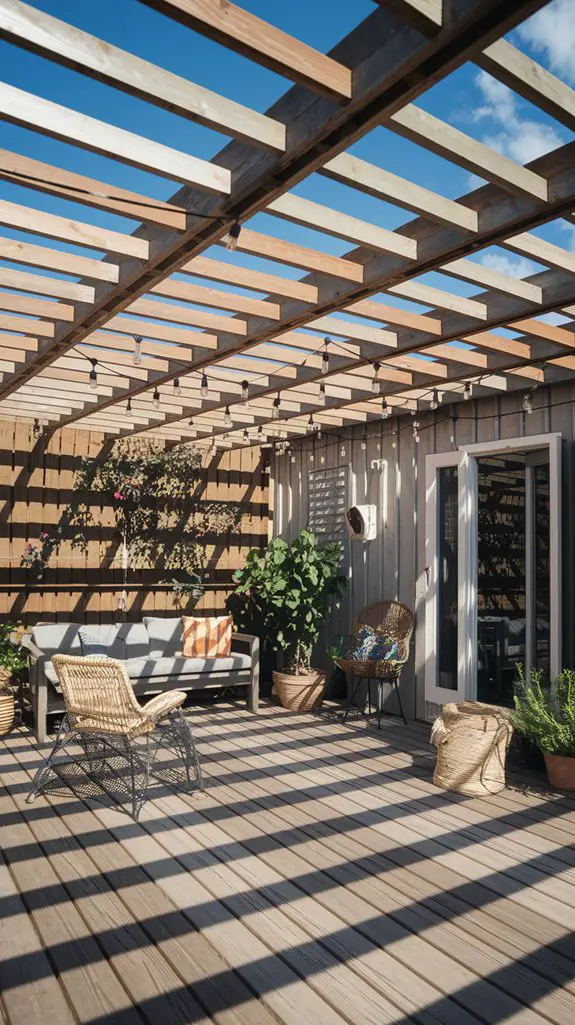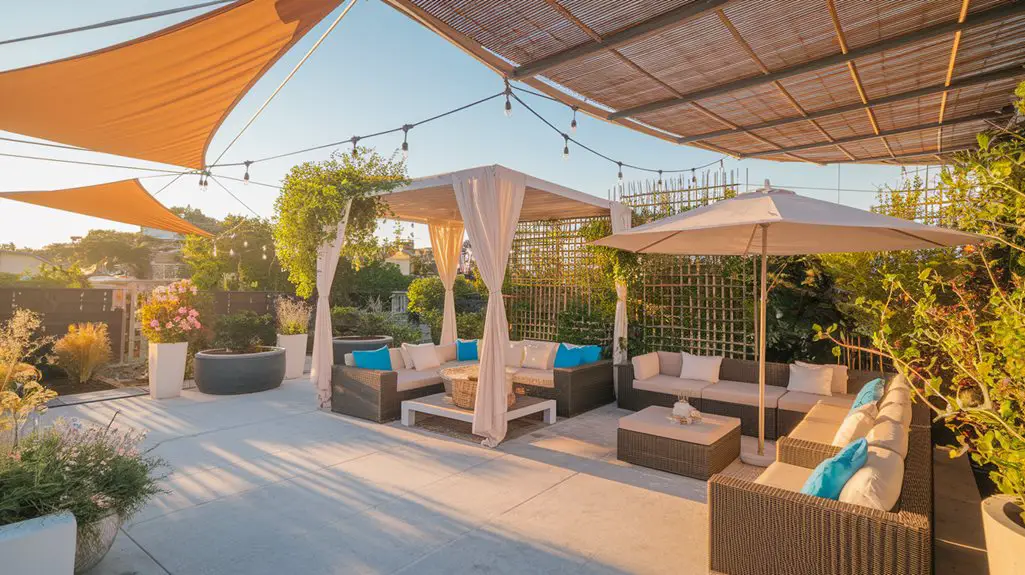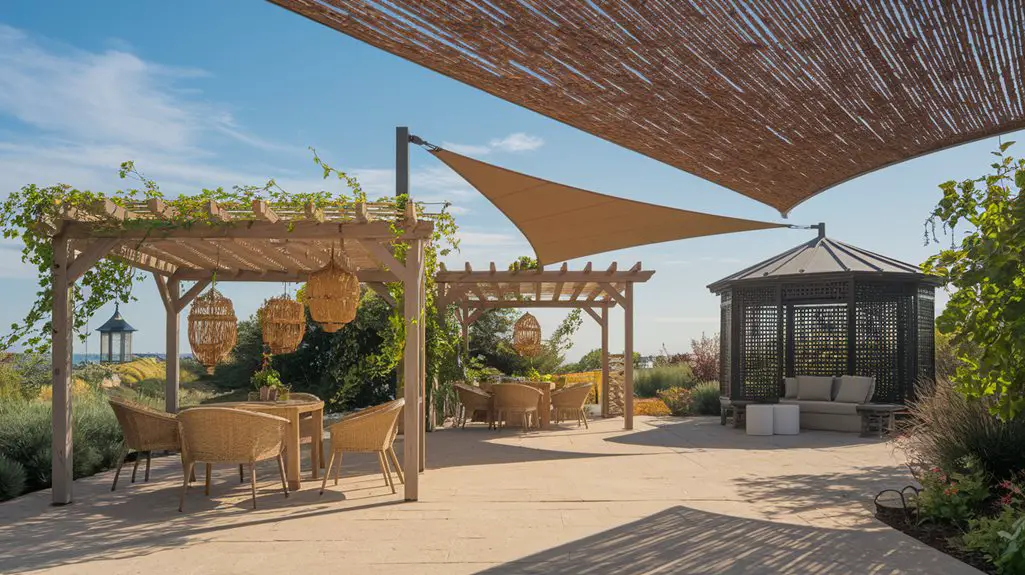The sun beats down on your patio, casting harsh shadows and radiating heat that makes your outdoor haven nearly unbearable. You’ve invested time in creating the perfect outdoor space, but without proper shade, you can’t fully enjoy it during summer’s intensity. Transforming this sun-drenched area requires thoughtful design solutions that balance aesthetics with functionality. These ten DIY shade projects offer architectural elegance and sustainable approaches to cooling your outdoor space—each one crafted to suit different styles, budgets, and technical abilities.
Stylish Pergola With Retractable Canvas Cover
When elegantly designed, a pergola with a retractable canvas cover transforms your outdoor space into a versatile haven that adapts to changing weather conditions.
The careful integration of wooden beams with fabric creates a harmonious balance between structure and flexibility.
Select sustainable hardwoods like cedar or redwood for their natural resistance to decay and insects. Additionally, using eco-friendly pergola materials can further enhance the sustainability of your project.
Position your pergola to optimize shade during peak sun hours while preserving sightlines to your garden’s focal points.
For the retractable element, install marine-grade canvas on a pulley system or tracks.
This allows you to extend full coverage during intense sunlight or retract it when you desire dappled light.
The precision of your measurements matters—ensure the canvas sits taut when extended to prevent water pooling and maintain the pergola’s architectural integrity.
DIY Outdoor Curtain Panels for Instant Shade

Outdoor curtain panels offer an elegant, adaptable solution for immediate shade while introducing textural dimension to your patio environment.
By suspending flowing fabrics from strategic points, you’ll create a dynamic interplay between light, privacy, and protection from the elements.
Select materials thoughtfully for your custom installation:
- Weather-resistant fabrics like Sunbrella or polyester blends resist fading and mildew
- Galvanized steel conduit or curtain rods provide structural integrity at minimal cost
- UV-resistant thread guarantees longevity in all seams and hemming
- Stainless steel grommets facilitate smooth movement along your chosen hardware
Additionally, choosing top materials that suit both your aesthetic and functional needs can enhance the overall effectiveness of your shade solution.
Install curtain panels between existing architectural elements or create dedicated posts, positioning them to intercept harsh sunlight during peak hours.
When not needed, simply tie back these functional textiles to maintain airflow while preserving your designed aesthetic.
Budget-Friendly Pallet Shade Structure

Repurposing wooden pallets into an overhead shade structure transforms discarded materials into architectural elements that deliver both relief from the sun and rustic charm to your outdoor living space.
Begin by deconstructing pallets into uniform planks, preserving structural integrity. Mount vertical supports at each corner of your designated area, ensuring they’re anchored securely in concrete footings.
Construct a framework atop these posts using the sturdiest pallet beams, creating a grid pattern that maximizes stability while maintaining visual lightness.
For coverage, arrange remaining slats perpendicular to your frame, leaving calculated gaps for dappled light. Apply a weather-resistant sealer to extend longevity.
Consider climbing vines like wisteria or jasmine to enhance shade density and introduce natural cooling through evapotranspiration. Additionally, using sustainable building materials can further contribute to an eco-friendly outdoor project.
Sail Shade Installation Guide
Triangular sail shades offer the perfect balance between aesthetic minimalism and functional sun protection, transforming your patio into a contemporary outdoor retreat with architectural flair. When installing these versatile canopies, precision guarantees both structural integrity and visual harmony.
- Measure your space meticulously, accounting for mounting points that create ideal tension while maintaining proper water runoff angles (at least 18° slope).
- Select hardware appropriate for your mounting surfaces—stainless steel fixtures resist corrosion and complement the sail’s clean lines.
- Install anchor points securely into structural elements like posts, walls, or reinforced fascia boards.
- Tension the fabric evenly using turnbuckles, allowing slight give for wind resistance while maintaining the sail’s geometric purity. Additionally, consider exploring affordable patio shade ideas that can enhance your outdoor experience while keeping the budget in check.
Repurposed Vintage Window Awning Project
While sail shades convey modern elegance, vintage window awnings offer character through architectural reclamation. You’ll find these forgotten treasures at salvage yards, estate sales, or online marketplaces—often at reasonable prices despite their historical value.
Begin by thoroughly cleaning your vintage awning, removing rust with a wire brush and vinegar solution. Replace deteriorated fabric with weather-resistant canvas in a complementary color to your outdoor space.
Reinforce the frame’s structural integrity by welding weak joints and applying rust-inhibiting primer. Mount your restored awning using galvanized brackets appropriate for your exterior wall material.
Calculate precise angles to maximize shade during peak sun hours. The awning should protect without overwhelming your patio’s proportions. Additionally, incorporating stylish privacy fencing alongside your awning can enhance your outdoor experience by providing a more secluded atmosphere.
This sustainable upcycling project reduces landfill waste while infusing your outdoor sanctuary with authentic architectural heritage impossible to replicate with mass-produced alternatives.
Potted Plant Privacy Screen With Shade Benefits
For homeowners seeking dual functionality in their outdoor elements, a strategically designed plant privacy screen delivers both intimate seclusion and beneficial shade patterns across your patio area. You’ll find the architectural interplay between negative space and verdant foliage creates a living boundary that transforms throughout seasons.
- Select tall, columnar plants like bamboo or Italian cypress for vertical structure, placing them in weather-resistant containers aligned with your patio’s aesthetic language.
- Layer with mid-height varieties featuring broad leaves (fatsia, banana plants) to maximize shade density and create cooling microclimates.
- Incorporate trailing specimens that cascade over containers, establishing visual rhythm while filling spatial gaps.
- Position containers on casters or elevated platforms to adapt your living screen as sunlight angles shift throughout the day and seasons. Additionally, consider integrating creative privacy screens that not only enhance the aesthetic appeal but also provide functional benefits to your garden landscape.
Bamboo Roll-Up Shade Solution
Natural and architecturally elegant, bamboo roll-up shades transform outdoor spaces through their perfect balance of form and function. You’ll appreciate how these versatile installations filter harsh sunlight while preserving your connection to the outdoor environment. Additionally, these shades offer an ideal solution for shade ideas for patios that are exposed to direct sunlight.
| Mounting Option | Aesthetic Impact | Durability Factor |
|---|---|---|
| Pergola-top | Layered dimensionality | Weather-resistant |
| Wall-mounted | Clean architectural lines | UV-stabilized |
| Tension-wire | Floating visual element | Wind-tolerant |
| Freestanding | Sculptural presence | Reinforced edges |
Installation requires minimal tools—simply secure mounting brackets, align the roll mechanism, and establish a reliable tensioning system. For enhanced longevity, apply natural oil sealants annually. When selecting bamboo thickness, consider your climate; dense weaves offer superior protection in extreme heat, while lighter options permit a dappled light effect appropriate for moderate conditions.
Upcycled Door Canopy for Patio Edge
Transforming abandoned wooden doors into striking overhead canopies represents perhaps the most resourceful shade solution for defining patio boundaries.
These architectural elements, with their inherent structural integrity, provide both functional shade and visual interest along your patio’s perimeter.
To create your door canopy:
- Select solid wooden doors with intact frames—antique paneled varieties offer superior aesthetic appeal.
- Remove hardware, strip finishes, and apply weather-resistant sealant to guarantee longevity.
- Mount metal brackets at precisely measured intervals along your patio edge.
- Install doors horizontally at a 15° angle for ideal afternoon sun deflection.
The resulting installation creates a rhythmic shadow pattern that shifts throughout the day, casting dappled light across your outdoor space while maintaining the sustainable ethos of repurposing architectural salvage. Additionally, using eco-friendly materials in your garden design can further enhance sustainability.
Weekend Wooden Slat Overhead Shade Project
Crafting a wooden slat overhead structure delivers sophisticated shade while maintaining visual lightness—a perfect weekend project for the design-conscious homeowner. You’ll achieve architectural sophistication through calculated spacing that filters sunlight rather than blocking it entirely. Incorporating a rustic garden pathway can enhance the overall aesthetic of your outdoor space.
| Material Options | Spacing Considerations | Finishing Techniques |
|---|---|---|
| Cedar (weather-resistant) | 1:1 slat-to-gap ratio | Transparent stain |
| Reclaimed timber | 70% coverage for dappled light | Oil-rubbed finish |
| Thermally modified pine | Directional orientation for seasonal sun | Weather-resistant sealant |
Begin by establishing four corner posts anchored in concrete footings. Mount supporting crossbeams, ensuring precise levelness. Install slats perpendicular to the sun’s strongest trajectory, spacing them mathematically for your desired shade-to-light ratio. Consider integrating climbing plants for seasonal variation in coverage and temperature regulation—transforming a practical shade solution into a living architectural element.
Climbing Plant Trellis Shade System
Living architecture reaches its pinnacle with a well-designed climbing plant trellis system—merging botanical elements with structural precision to create dynamic, evolving shade.
You’ll transform your patio’s microclimate through calculated botanical integration, establishing a sustainable cooling mechanism that evolves with each growing season. Your framework becomes both sculpture and functional shade element.
- Install a geometric steel or cedar framework anchored to your patio’s perimeter.
- Select appropriate climbers (wisteria, grape, jasmine) based on growth rate and density.
- Implement a strategic irrigation system with precision drip emitters.
- Establish maintenance zones with accessible pruning points for seasonal control.
This symbiotic shade solution delivers progressive coverage while embodying biophilic design principles—your patio becomes a living example of form following function without sacrificing aesthetic integrity. Additionally, consider incorporating firewood storage solutions that harmonize with your landscape to enhance the overall outdoor experience.
Conclusion
With these ten meticulously crafted shade solutions, you’ve now acquired the architectural vocabulary to transform your exposed patio into a precisely calibrated outdoor sanctuary. Remarkably, studies show properly designed shade structures can reduce ambient temperatures by up to 15°F, creating microclimates that extend your outdoor living season. As you implement these sustainable designs, you’re not merely creating shade—you’re orchestrating the interplay between light, space, and comfort with deliberate precision.



